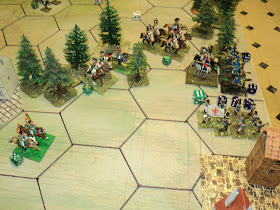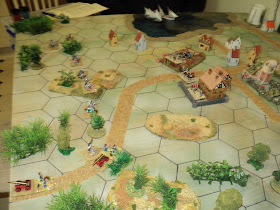 |
| Opening clashes on the French right |
The Battle of Portable Waterloo began traditionally, with assaults upon the Allied left, and the Hougoumont strongpoint that acted as bastion defending the Allied right. The first attacks upon the plantation south of the chateau itself were carried out by
9th Division from the southeast and the leading brigade of
6th Division from the southwest. The defenders there were fairly shortly driven in, whereat the
9th Division entered the wooded enclosure to assault the chateau itself.
 |
6th and 9th Divisions attacking the Hougoumont
plantation |
Seizing the initiative (higher initiative roll), the
2nd and
4th French Divisions of I
Corps quickly occupied the hamlets of Papelotte and Frichemont.
Third Division took up the space between, while
1st Division remained echelonned to the left rear of the line. The
I Corps artillery took up a battery position behind Papelotte, from which position they brought La Haye Sainte under fire. The
Allied reserve artillery there were quickly compelled to abandon the position, which was soon taken up by the British/Hanoverian
3rd Division. Henceforth, all formation identities will be colour coded: French
Blue, anglo-Dutch
Red, Prussian
Black.
 |
| General view, looking west from Paris Wood |
The seizure of Frichemont gave the
1st Cavalry Division the opportunity to swing through the defile between that place and the Paris Wood, to fall upon the Allied Flank. However, the
5th Division commander had detached betimes his trailing brigade, the
5th Hanover, which, hastily forming square, stood off the French light horse. The Cavalry of
4th and 6th Allied Brigades waiting overlong to respond, left the inexperienced Hanoverians on their own, not only against the French light horse, but also the cuirassiers of
Milhaud's leading Division.
 |
| General view looking SW. |
As the
5th Hanover Bde fought its private little battle against heavy odds, the rest of the
5th Division, together with the
2nd Dutch-Belgian and the
6th Divisions, began a series of assaults upon the French positions about the villages. This had the effect of stalling the French attack altogether, the Allies unable for a considerable time to break in, but the French unable to break out.
 |
The battle on the east flank. In the hands of 5th Hanover Bde
lies the safety of the Allied left flank. Where are 4th and
6th cavalry brigades? |
About the Hougoumont,
9th Division, having cleared the plantation, was beginning its assaults upon the Chateau complex itself. On the road to its left, a brigade of
Jerome Bonaparte's 6th Division was also engaged in the same emprise. The prolonged fighting tended to draw in the
5th Division as well, so that the beleaguered garrison was for a time facing adds of at least twelve to one, almost the whole of the II Corps infantry. That not all
II Corps could assault at once reduced the odds to seven to one, but that simply meant the attackers had plenty of reserves available.
 |
Two and a half French Divisions attack the Hougoumont
at odds of at least seven to one |
This did not, of course, account for the large bodies of Allied troops unengaged behind the Hougoumont, available for reinforcement or counterattack as the Allied chose. They were not long choosing.
For the moment the action looked deadlocked along the whole front. Then the
4th and 6th Cavalry Brigades lurched into motion, and thundered down upon the French
1st Cavalry Division. Stuck in a salient hemmed in by the Paris Wood,
Milhaud's Cavalry and the
Hanoverian square; already having taken heavy losses, and now facing odds of five to one into the bargain,
Jacquinot's light horse stood no chance. They were scattered to the winds.
 |
Allied cavalry - 4th and 6th Brigades - charge a
much depleted French 1st Cavalry Division |
Having taken so long to get going, the British light dragoons were now hard to stop. On they went, straight for the
13th Cuirassier Division, led by
General Milhaud himself. The heavy weight of the French horse was enough to bring the lighter Allied to a standstill. They fell back, alongside the relieved Hanoverians, both congratulating themselves that, for little loss (1SP lost to
5th Hanover) they had smashed an enemy cavalry Division, and shored up the open flank. For their part, the cuirassiers also drew back where they united with the
14th Cavalry Division.
 |
| Charging ever onward... |
 |
The Allied left now safe, the opposing horse there
fall back to regroup and keep watch and ward |
I should probably mention at this point that were I to do this again, I rather think I would place the Hougoumont two hexes closer to the western edge of the table. It seems that there was historically very little action west of the place, the chateau and its grounds practically forming the battlefield's boundary on this flank in the same manner that the Paris Wood formed one on the other flank. So it was, in this incarnation of the battle, that on the French side,
Jerome was to detach a brigade from his Division, whilst the whole of
Kellermann's III Cavalry Corps would join
2nd (Light) Cavalry Division to protect the flank of the assault upon the Hougoumont. With
Milhaud's heavies also drawn to a flank, there would be no charge of the heavy horse upon the Allied line between Hougoumont and La Haye Sainte. And yet, a mounted French attack would eventually be directed thereto, late in the day...
 |
| Kellermann's Cav Corps moving off to the west flank... |
The allies were already in motion. The inexperienced but numerous
3rd Dutch-Belgian Division (12SP in 2 Brigades) were moving up from Braine d'Alleud, to join counter-attacks by
3rd and 5th light cavalry Brigades, and
2nd Infantry Division. It was not long before
Jerome found himself fighting off the attentions of Allied horse and foot, and no time for the Hougoumont. In any case, surely the place must fall soon, even without his Division?
The fighting on the flanks left rather a vacuum in the centre. The rival artilleries settled down to what was largely a counter-battery duel (much to my annoyance: I
hate counter-battery!).
I and II Corps largely syphoned off to the flanks,
General Count Lobau's VI Corps, weakened by detachments to Marshal Grouchy's command, began moving slowly up to fill the space between the
Guard artillery in action along the road up from Maison du Roi, and the right flank of
II Corps. A lucky salvo from the
Allied II Corps artillery gave a check to the trailing
20th Division - a gap opened up between the columns, and
Lobau was finding it difficult to get the
Corps united again (a really bad activation die roll).
For their part, the
Imperial Guard remained motionless in and about Maison du Roi, when they might usefully have moved forward even a short distance, that it's
masse de rupture might be thrown in in a timely fashion. Only the Guard artillery were in action - at least for the time being. The only other move was to bring in the Guard heavy cavalry closer to the main body of the Guard infantry.
So matters stood, perhaps a couple of hours into the action, the opposing forces heavily engaged on both flanks.
D'Erlon's I Corps continued to cling on to Papelotte and Frichemont, without being able, yet, to force their way beyond. Allied attempt to wrest the villages from the enemy were proving equally fruitless, as losses mounted on both sides. The garrison of the Hougoumont refused to be shifted, and
II Corps was equally stuck fast. The French build-up in the centre was proceeding much too slowly.
 |
| General view, just before... |
So matters stood. But now a dark cloud began to appear in the east, a shadow spilling over the ground between the Paris Wood and Maransart Village. It might have been
Marshal Grouchy's command, so far south along the battlefield edge did the shadow appear. But Marshal Grouchy this was not. The lead elements of the
Prussian Army had arrived.
 |
... the arrival of the lead elements of the Prussian
IV Army Corps... |
To be continued - The Prussians




















































